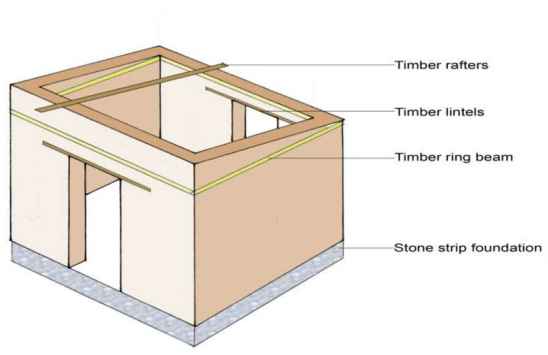The load bearing structure is carried by load-bearing partitions in load-bearing buildings.
Load is transferred to the soil surface.
This kind of structural system does not include a column and beam framework.
In this article you’ll learn:
- Introduction of the load-bearing structure.
- Components of the load-bearing structure.
- Merits and Demerits of the load-bearing structure.
- Lots more.
So, if you’re ready to go with it, this article is for you.
Let’s dive right in.
What Is a Load Bearing Structure?
These structure is made up of building components that securely carry and transfer the loads to the ground.
The building’s durability, stability, and efficiency are all ensured by this structure.
Load-bearing structures can be used to build residential and commercial structures up to the ground floor + 2 stories for a minimum cost.
The components of these structure are those of a building that safely carry and transfer the load to the ground.
These structures are commonly found in residential buildings with small room proportions.

Components of Load Bearing Structure:
The following are the main load-bearing structural elements as follows:
Beam:
Beams are of fundamental load-bearing structural components and can be made of wood, concrete, or steel.
The depth and breadth of the simple beam define the load-bearing capability of the beam section, which is a major member used to carry the weight on the structure.
Beams are subjected to a lot of internal and external forces, as well as a lot of tensile and compressive forces.
Columns:
The structural columns are one of the essential structural components that play a significant role in conveying dead and live loads to the foundation to which the building load is applied.
Load-bearing walls:
These walls, which can be formed of concrete, block materials, or other materials, carry loads from slabs beneath them to the base.
The majority of a building structure’s outer walls are designated load-bearing, and after offering alternative support, the load-bearing wall’s above-supported components must be eliminated as part of the renovation.
Braces:
Braces are load-bearing structural components in the framework structural system that aid in successfully stiffening the structures.
Trusses:
These load-bearing parts that sustain the roof elements in the buildings uniformly transfer roof loads to the truss.
Advantages of the load-bearing structure:
- The foundation, beams, and columns of these structures are made of brick.
- Because the load-bearing capability of brick is substantially lower than that of RCC, a brick foundation requires a more massive foundation area than an RCC framed structures.
- It has a thick brick wall that provides additional weather resistance and noise absorption. results in less accessible space.
- Although bricks are inexpensive, it is suitable for structures with fewer than two floors.
- Although rebars in RCC can melt in a fire, it is useful for fire resistance. Well, that’s what caused the World Trade Centre tower to collapse.
- Shock waves cause uneven tension and compression in columns in load-bearing structures, and tension is borne in large part by RCC steel, which is not present in load-bearing structures.
Disadvantages of load-bearing structure:
- This is ideal for constructions of up to three stories, and it is impossible to adjust the location of the walls after construction.
- The earthquake resistance is poor.
- The requirement for thick walls is a significant disadvantage of this method.
- As a result, the carpet area decreases.
Also read: Types of Structures | Load Bearing Wall | RCC Framed Structure
Conclusion:
In the early days of construction, load-bearing structural design was a common practice.
As opposed to a load bearing structure, the framed structural design consists of the framed beam and column structures that provide superior lateral force resistance and are more adjustable.

Related Posts
Rock Quality Designation(RQD): Building Strong Foundations
Spread Footing
Masonry Cement
Plain Cement Concrete
Concrete Efflorescence
Concrete Pile
Stepped Footing
Fineness Modulus of Coarse Aggregates
Difference between Condo and Apartment